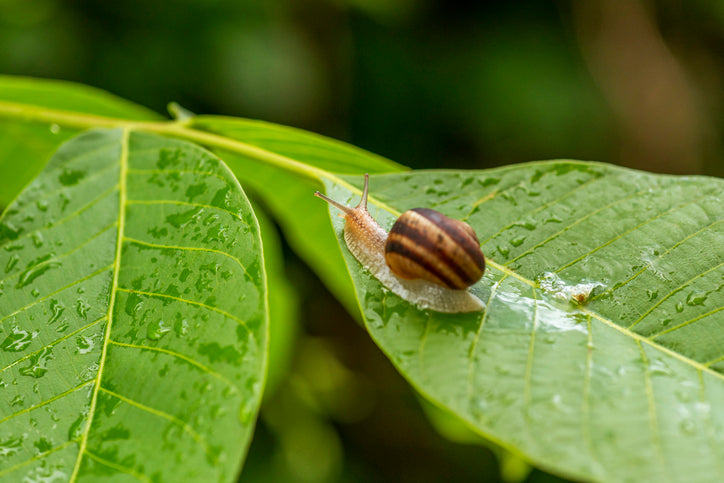
Combat snails with these tips!
|
|
Time to read 4 min
|
|
Time to read 4 min
Are you having trouble with snails in your garden? Are you worried about the damage these unwanted guests can do to your plants? Don't panic! Fortunately, there are several animal-friendly ways to combat snails, so that you can once again enjoy a beautiful garden and a rich harvest.
If you look around in spring and summer, you will see them crawling around everywhere - snails! But where do these special animals actually come from? And how do they manage to survive the harsh winter months?
As soon as temperatures drop below 5C, snails start looking for a sheltered place to hibernate. They find these places mainly under leaves, stones or in the ground. There they retreat into their house and close the opening with a layer of mucus that dries to a hard lid, the so-called epiphragm. This protects them from dehydration and cold during hibernation.
Only when temperatures rise again in spring do the snails come out of hibernation. They then go out again to eat and reproduce. In this way, these special animals manage to survive the harsh winter months every year.
If you have to deal with snails in your home, this can be an annoying problem. These small intruders often find their way inside in search of moisture and food. You usually find them in damp areas such as the bathroom or kitchen. Although snails do not pose a direct danger, they can damage plants and leave behind nasty slime trails.
Fortunately, there are several ways to get rid of these unwanted guests. The first step is to make sure that your home is well ventilated and that there are no damp places where snails feel at home. This makes your home less attractive to these crawling creatures.
You can then use slug pellets or salt around doors and windows to prevent them from coming in. These methods create a physical barrier that makes it difficult for slugs to enter your home.
If you unfortunately already have snails in your home, you can remove them manually and release them outside. This is an effective way to get rid of the intruders without using harmful chemicals.
Unfortunately, snails can cause a lot of damage to your carefully cultivated plants and vegetables. These hungry creatures love young, tender leaves and can devour entire plants in no time. Fortunately, there are several effective ways to keep snails out of your garden in an animal-friendly way.
One of the most effective methods is to create barriers around your vulnerable plants. For example, sprinkle a border of crushed eggshells, coffee grounds or sharp sand around the plants. Slugs do not like these sharp edges and will avoid these barriers. You can also place small wooden or plastic borders around your plants. Slugs cannot crawl over these.
In addition, you can attract snail predators to your garden, such as hedgehogs, birds and toads. These animals love snails and help keep your garden snail-free in a natural way. For example, place a hedgehog or birdhouse, or create a pond or damp place where toads feel at home. By offering these natural enemies of the snail a place, you work in an animal-friendly way towards a healthy garden without a snail plague.
View this post on Instagram
It is easy to use beer as a slug repellent. Fill shallow bowls or containers with beer and place them in various places in your garden, especially around the plants that are most affected by the feeding damage. The slugs will be attracted to the beer and will drown in it. Replace the beer regularly so that it always remains fresh and effective.
There are several methods to combat slugs directly. One of the most effective ways is to use slug pellets. These pellets contain a poison that kills the slugs when they eat them. Apply the pellets around the plants you want to protect. Be careful, because some slug pellets can also be harmful to pets or other animals in your garden.
A more environmentally friendly alternative is to place snail traps. Here you use a container filled with beer or another bait. The snails are attracted by the smell and drown in the container. Emptying and refilling is necessary to keep the trap effective.
Another option is to apply a physical barrier around your plants. This can be done with copper strips or sharp materials such as eggshells or coffee grounds. The snails cannot crawl over this and are thus kept out of your plants.
Snails often lay their eggs in the ground, under leaves or in other moist places. If you leave these eggs, they will hatch and you will have to deal with a new generation of snails. By removing the eggs, you prevent the population from expanding quickly and prevent further damage to your plants.
Snail eggs are usually white or translucent in color and round or oval in shape. They are often laid in groups of 20 to 100 eggs.
It is best to remove snail eggs manually.
Go through your garden regularly and carefully search for snail eggs, collect them and dispose of them by throwing the eggs away.
